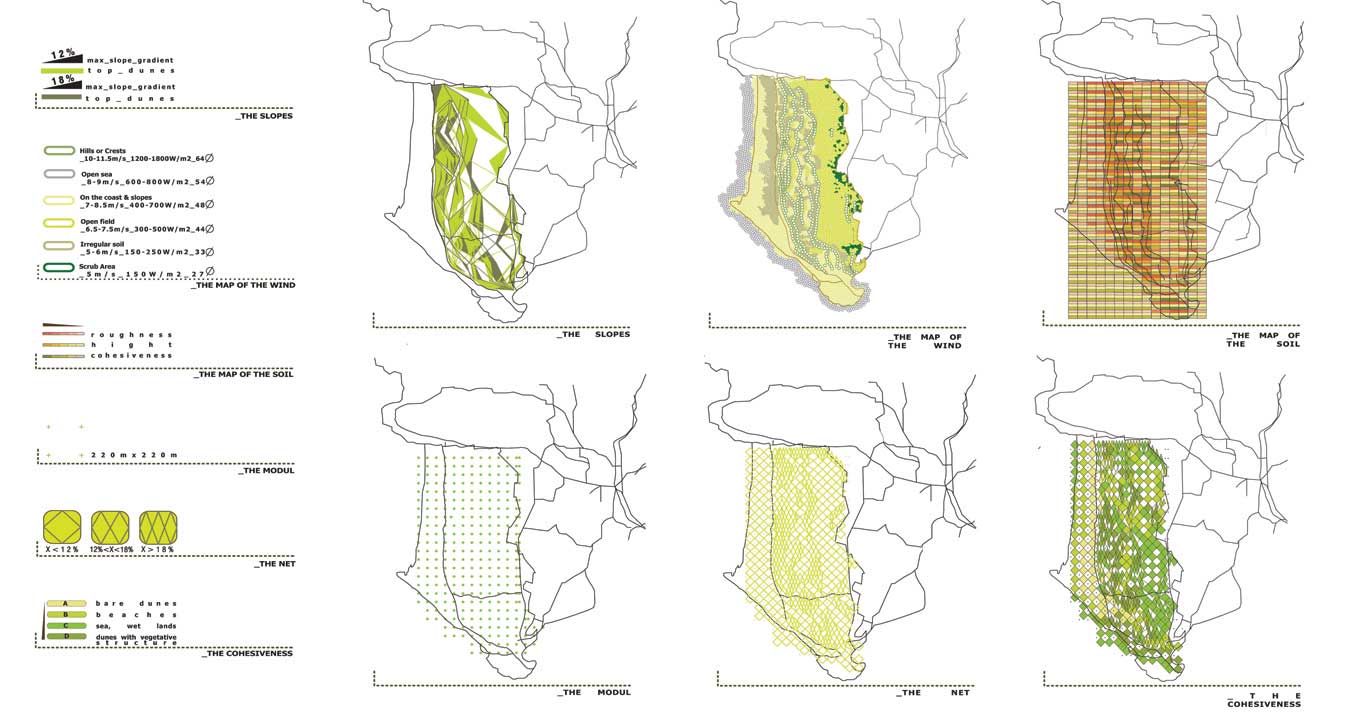Netted Dunes Master plan, Braunton Barrows_UK
‘[…] each city receives its form from the desert it opposes.’ Italo Calvino, ‘Invisible Cities’, 1972
The ‘Netted Dunes’ are a specific prototypical solution for urban planning on coastal sand dunes. These areas which usually remain uninhabited because of the instability of the ground and the lack of drinkable water are on the other hand rich in eolic energy and strategically close to the sea, an additional potential resource. The prototype, exportable to different places with the same characteristics, stabilizes the site to enable urban organizations and exploits the energy created by the local winds to run a sea water desalination process. The water so produced will be stored on site through a series of pools and will be able to accommodate the need of the local community as well as to feed the agricultural fields placed at the edge of the new development. It consists in a system of artificially stiffened dunes, multiple infrastructures and generic programmatic pockets set up in an energetic, autotrophic field of connections between the land and the sea. A draining system, alimented by a net of aero motors set up throughout the site, feeds regularly the natural structure of the dunes, the marram grass, enhancing the stability of the ground through the control of its cohesiveness, enabling the organization of urban activities and spaces
- [location] Braunton Burrows_UK
- [status] Completed in 2002
- [program] Urban Planning for a mixed use development
- [size] 1200hectares
- [client] AAMa Thesis
- [architect] Ilaria Di Carlo
- [Link] 'The Flood', catalogue of the 5th Rotterdam Biennale, 2005, NAI; AA Review Catalogue 2002;
Netted Dunes Master plan, Braunton Barrows_UK
‘[…] each city receives its form from the desert it opposes.’ Italo Calvino, ‘Invisible Cities’, 1972
The ‘Netted Dunes’ are a specific prototypical solution for urban planning on coastal sand dunes. These areas which usually remain uninhabited because of the instability of the ground and the lack of drinkable water are on the other hand rich in eolic energy and strategically close to the sea, an additional potential resource. The prototype, exportable to different places with the same characteristics, stabilizes the site to enable urban organizations and exploits the energy created by the local winds to run a sea water desalination process. The water so produced will be stored on site through a series of pools and will be able to accommodate the need of the local community as well as to feed the agricultural fields placed at the edge of the new development. It consists in a system of artificially stiffened dunes, multiple infrastructures and generic programmatic pockets set up in an energetic, autotrophic field of connections between the land and the sea. A draining system, alimented by a net of aero motors set up throughout the site, feeds regularly the natural structure of the dunes, the marram grass, enhancing the stability of the ground through the control of its cohesiveness, enabling the organization of urban activities and spaces





















